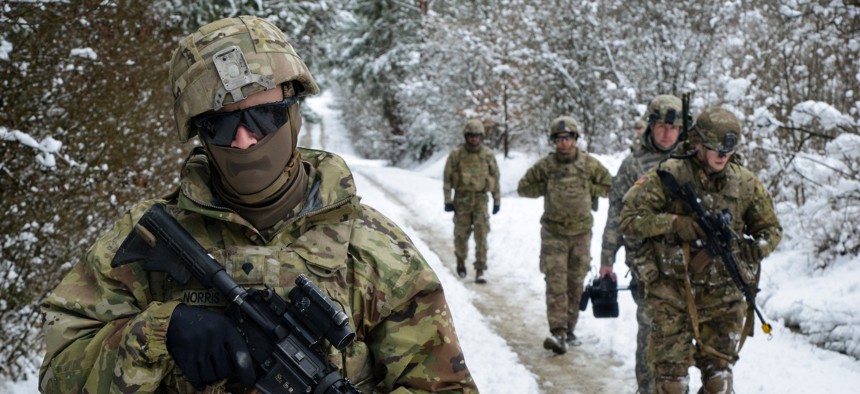
Army Spc. Paul Norris leads a group of soldiers conducting scouting operations at the Grafenwoehr Training Area, Germany, Feb. 28, 2020. Army Spc. Austin Riel
As America struggles with COVID-19’s expanding toll and its disastrous impact on the economy, the turmoil caused by George Floyd’s senseless killing, and President Trump’s responses to those troubles, a bit of good news leaked out. Trump has reportedly directed the Pentagon to withdraw 9,500 troops from Germany, about one-quarter of the U.S. force garrisoned there.
Trump’s suggestion brought predictable bipartisan alarm in Congress and editorial pages, but it’s actually a modest and overdue step that should be a down payment towards broader drawdown in Europe.
Of course, with Trump, it’s always possible one is debating piffle: theatrics that never become realities, like the supposed withdrawal of U.S. forces from Syria or the peace deal with North Korea. Regardless, this is a sound idea deserving defense, and is far more consistent with traditional American foreign policy than the reaction suggests.
At one point in the 1960s, the United States had almost 275,000 troops in Germany. That number fell to around 200,000 by Cold War’s end and steadily since then, to 34,500. The reduction reflects the decline in the Soviet/ Russian threat. Further diminishment is hardly revolutionary.
Related: It’s High Time for Germany to Fund, and Fix, Its Military
Related: The Strangely Quiet Visit of Germany’s New Defense Minister
The U.S. garrisoning of Germany was not originally meant to be permanent. The United States deployed troops to Germany early in the Cold War for two famous reasons: to keep the Soviet army out (that is, deterred from conquering West Germany and using it as a springboard to threaten the United States) and to keep West Germany down, which meant preventing its remilitarization and becoming a nuclear power. That would have alarmed European partners and potentially scared the USSR into starting World War III.
The U.S. deployment to Germany, and the NATO alliance it served, were remarkably successful. Not only did the alliance peacefully win the Cold War, but Europe largely got rich. In fact, the U.S. troop presence was overly successful in keeping Germany down. Like other NATO allies, it now happily lets the U.S. pay for a chunk of Europe’s collective defense and spends its own tax money on other priorities.
Meanwhile, U.S. elite thinking on NATO shifted. Instead of bringing all U.S. troops home after the end of the Cold War, new generations of U.S. leaders saw stationing some U.S. forces in Europe as a lever to boss its politics. The new idea—rarely articulated for fear of upsetting the allies—was to keep them dependent on protection lest they become a unified power that could buck U.S. leadership.
Compared to the Soviet Union, Russia isn’t much of a threat. It has half the population of the USSR and an economy smaller than Italy’s. The European allies, meanwhile, are about as rich as we are. Their economies are collectively more than ten times bigger than Russia’s, and they have about three times its population. Non-U.S. NATO countries also spend more than four times what Russia does on defense.
What’s lacking is the ability to use this power collectively and independently of U.S. hand-holding. Including the forces in Germany, we have more than 70,000 well-trained and well-equipped service personnel in Europe. Tens of thousands more are back home committed to Europe’s defense. The wars in Libya and Afghanistan show how dependent European allies are on U.S. help for intelligence and logistics support.
Long before Donald Trump got the job, U.S. presidents hectored Europeans to spend more on defense (albeit usually more politely). The Europeans reliably pledge to do more but never quite manage. NATO’s longstanding goal is having each member spend two percent of their GDP for defense—though hardly any of the major European countries meet it. The U.S. spends 3.5 percent of GDP on defense. Germany, Europe’s biggest and richest nation, spends 1.2 percent. It plans now to reach 2 percent by 2031 or so. Why rush, when the U.S. supplies the needed military muscle practically for free and Russia remains more bark than bite?
Removing troops from Germany is a better way to address this problem than simply complaining louder. If the shift means allies devote more effort to defense, that’s good. If they don’t, that too is fine, since the U.S. taxpayer saves either way.
Outraged columns greet any suggestion of lessening the U.S. military presence in Europe but ring a bit hollow. The warnings focus on symbolism and hurting allied feelings, but no one makes the case that U.S. security depends on an increment 10,000 troops in Germany. That Germany is essentially secure either way is hardly in dispute.
We’re often told that bases in Europe are key to U.S. military activities further afield in the Middle East. Recent U.S. experience suggests that this is a better rationale for closing European bases than for keeping them. In any case, Europeans will still seek U.S. friendship and provide bases if needed after a U.S. drawdown. Good relations needn’t depend on permanent garrisons.
It's time to defund our subsidization of rich European countries through NATO. This doesn’t mean entirely abandoning them, not immediately at any rate. It means reducing the U.S. defense commitment in Germany and elsewhere in Europe in recognition of the continent’s historic safety, recent Russian mischief notwithstanding. We can safely tell the Europeans we’ll be there if they really need us, in the safe assumption that they won’t. Let’s go back to the old plan, where their ability to take care of themselves means they should.




